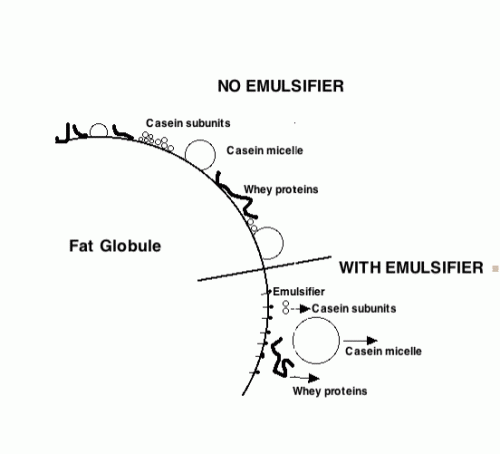Ice Cream Mix Ingredients
14 Emulsifiers

The emulsifiers are a group of compounds in ice cream that aid in developing the appropriate fat structure and air distribution necessary for the smooth eating and good meltdown characteristics desired in ice cream. Since each molecule of an emulsifier contains a hydrophilic portion and a hydrophobic portion, they reside at the interface between fat and water. As a result they act to reduce the interfacial tension or the force which exists between the two phases of the emulsion. This causes a desorption of protein from the fat droplet surface, which promotes a destabilization of the fat emulsion (due to a weaker membrane) leading to a smooth, dry product with good meltdown properties (see diagram on the right). Their action will be more fully explained in the structure of ice cream section.
The original ice cream emulsifier was egg yolk, which was used in most of the original recipes. Today, two emulsifiers predominate most ice cream formulations:
mono- and di-glycerides:
derived from the partial hydrolysis of fats or oils of animal or vegetable origin
polysorbate 80:
a sorbitan ester consisting of a glucose alcohol (sorbitol) molecule bound to a fatty acid, oleic acid, with oxyethylene groups added for further water solubility
Other possible sources of emulsifiers include buttermilk, and glycerol esters. All of these compounds are either fats or carbohydrates, important components in most of the foods we eat and need. Together, the stabilizers and emulsifiers make up less than one half percent by weight of our ice cream. They are all compounds which have been exhaustively tested for safety and have received the “generally recognized as safe” or GRAS status.

